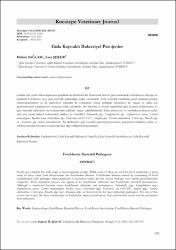| dc.contributor.author | Sağlam, Didem | |
| dc.contributor.author | Şeker, Esra | |
| dc.date.accessioned | 2016-07-27T13:35:53Z | |
| dc.date.available | 2016-07-27T13:35:53Z | |
| dc.date.issued | 2016 | |
| dc.identifier.issn | 2147-6853 | |
| dc.identifier.uri | http://kvj.aku.edu.tr/wp-content/uploads/sites/56/2016/06/2016_9_2_Article_7.pdf | |
| dc.identifier.uri | http://hdl.handle.net/11630/4317 | |
| dc.description.abstract | Gıdalar çok çeşitli mikroorganizma gruplarını içerebilmektedir. Bunlardan bazıları gıda üretiminde kullanılırken, birçoğu ise
gıdalarda bozulmaya veya gıda kaynaklı hastalıklara neden olmaktadır. Gıda kaynaklı hastalıklar genel anlamda patojen
mikroorganizmalar ya da mikrobiyel toksinler ile kontamine olmuş gıdaların tüketilmesi ile oluşan ve daha çok
gastrointestinal semptomlarla seyreden klinik tablolardır. Bu mikrobiyel kökenli hastalıklar; gıda kaynaklı infeksiyonlar ve
gıda kaynaklı mikrobiyel intoksikasyonlar şeklinde ortaya çıkabilmektedir. Gıda infeksiyon ve intoksikasyonlarına neden
olan çok sayıda bakteri bulunmakla birlikte, en önemlileri Salmomella spp., Campylobacter spp., Staphylococcus aureus, Listeria
monocytogenes, Bacillus cereus, Clostridium spp., Escherichia coli O157:H7, Shigella spp., Yersinia enterocolitica, Vibrio spp., Brucella spp.
ve Aeromonas spp. olarak bilinmektedir. Bu derlemede, gıda kaynaklı bakteriyel patojenler, patojenlerin bulaşma yolları ve
infeksiyonlardan korunma konusunda kısa bilgi verilmesi amaçlanmıştır. | en_US |
| dc.description.abstract | Foods can comprise the wide range of microorganism groups. While some of these are used for food production, a great
many of these cause food deterioration and food-borne diseases. Food-borne diseases caused by consuming of food
contaminated with pathogen microorganisms or microbial toxins are the clinical findings seen mainly gastrointestinal
symptoms. These microbial diseases can appear to be food-borne infections and food-borne microbial intoxications.
Although a numerous bacteria cause food-borne infections and intoxication, Salmomella spp., Campylobacter spp.,
Staphylococcus aureus, Listeria monocytogenes, Bacillus cereus, Clostridium spp., Escherichia coli O157:H7, Shigella spp., Yersinia
enterocolitica, Vibrio spp., Brucella spp. and Aeromonas spp. are known to be the most important pathogens. The aim of this
review was to give the short information on food-borne bacterial pathogens, their transmission routes and the protection
from infections. | en_US |
| dc.language.iso | tur | en_US |
| dc.publisher | Afyon Kocatepe Üniversitesi | en_US |
| dc.identifier.doi | 10.5578/kvj.23164 | en_US |
| dc.rights | info:eu-repo/semantics/openAccess | en_US |
| dc.subject | Epidemiyoloji | en_US |
| dc.subject | Gıda Kaynaklı Bakteriyel Hastalık | en_US |
| dc.subject | Gıda Kaynaklı İntoksikasyon | en_US |
| dc.subject | Gıda Kaynaklı | en_US |
| dc.subject | Bakteriyel Patojen | en_US |
| dc.title | Gıda Kaynaklı Bakteriyel Patojenler | en_US |
| dc.title.alternative | Food-borne Bacterial Pathogens | en_US |
| dc.type | article | en_US |
| dc.relation.journal | Afyon Kocatepe Üniversitesi, Kocatepe Veteriner Dergisi | en_US |
| dc.department | Gıda Kaynaklı Bakteriyel Patojenler | en_US |
| dc.identifier.startpage | 105 | en_US |
| dc.identifier.endpage | 113 | en_US |
| dc.identifier.issue | 2 | en_US |
| dc.relation.publicationcategory | Makale - Ulusal Hakemli Dergi - Kurum Yayını | en_US |



















